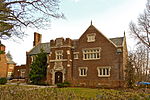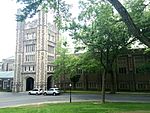Prospect House (Princeton, New Jersey)
1851 establishments in New JerseyHistoric district contributing properties in Mercer County, New JerseyHouses completed in 1851Houses in Princeton, New JerseyNRHP infobox with nocat ... and 4 more
National Historic Landmarks in New JerseyNational Register of Historic Places in Mercer County, New JerseyPrinceton University buildingsUse mdy dates from August 2023

Prospect House, known also as just Prospect, is a historic house on the Princeton University campus in Princeton, Mercer County, New Jersey, United States. Built in 1851, it is a fine example of the work of architect John Notman who helped popularize Italianate architecture in America. Notable residents include Woodrow Wilson during his tenure as president of the university. The building now serves as a faculty club. It was designated a National Historic Landmark in 1985 for its architecture and historic associations.
Excerpt from the Wikipedia article Prospect House (Princeton, New Jersey) (License: CC BY-SA 3.0, Authors, Images).Prospect House (Princeton, New Jersey)
Streicker Walk,
Geographical coordinates (GPS) Address Nearby Places Show on map
Geographical coordinates (GPS)
| Latitude | Longitude |
|---|---|
| N 40.346930555556 ° | E -74.656769444444 ° |
Address
Prospect Gardens
Streicker Walk
08544
New Jersey, United States
Open on Google Maps










